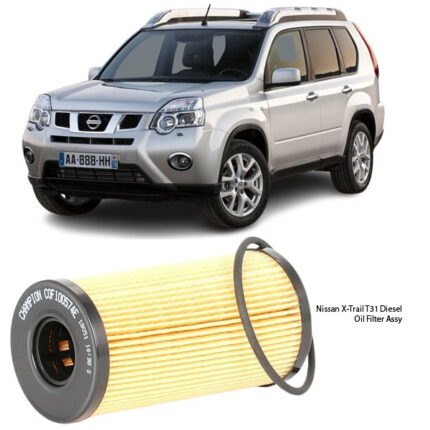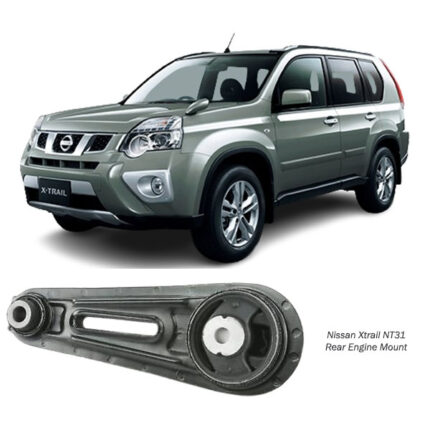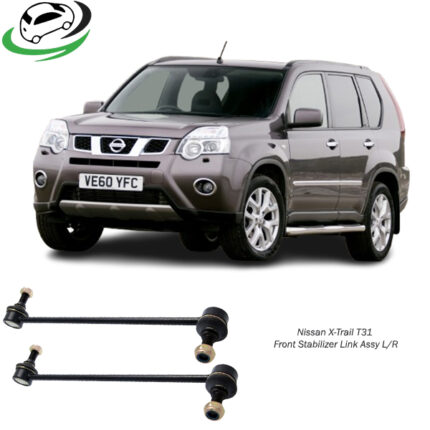Get Nissan X-Trail T-31 Front Stabilizer Link Assy L/R 54618-JD00A in Kenya
The front stabilizer link assembly, also known as the sway bar link or anti-roll bar link, is an integral part of a vehicle’s suspension system, primarily contributing to the vehicle’s stability, handling, and ride quality. Positioned on the front left (L) and right (R) sides of the vehicle, the front stabilizer link assembly connects the sway bar (also called an anti-roll bar) to the suspension components. This connection limits body roll during cornering and helps distribute weight evenly across the wheels. Understanding the structure, function, benefits, maintenance needs, and potential issues of the front stabilizer link assembly sheds light on how it improves driving dynamics and safety.
1. Structure and Components of the Front Stabilizer Link Assembly
The front stabilizer link assembly is a relatively simple yet crucial component that bridges the stabilizer bar and the control arm or strut of the vehicle’s suspension. Each assembly typically comprises:
- Link Rod: A solid or hollow rod that provides the primary structural connection. The rod can be made of steel, aluminum, or composite materials, depending on the design and performance requirements.
- Ball Joints (Ball Studs): Positioned at each end of the link rod, these joints connect the stabilizer link to the sway bar and the suspension. They allow for rotational and pivoting movement, accommodating changes in the angle as the suspension moves up and down.
- Bushings: In some stabilizer links, rubber or polyurethane bushings are added around the ball joints or at attachment points to dampen vibrations and reduce noise.
- Mounting Hardware: Nuts, bolts, and washers secure the link to the sway bar and suspension. They ensure a tight fit, preventing the link from loosening over time due to vibration or movement.
The assembly’s left (L) and right (R) designations indicate which side of the vehicle they’re installed on. Each side has an identical but opposite orientation, allowing the sway bar to be connected to both front wheels.
2. Function of the Front Stabilizer Link Assembly
The primary function of the front stabilizer link assembly is to limit body roll, helping the vehicle stay level when cornering. Here’s how it operates:
a. Linking the Sway Bar to the Suspension
The stabilizer link assembly physically connects the sway bar to the suspension control arms or struts. When the vehicle encounters uneven terrain or turns at high speeds, the sway bar distributes the load between the wheels through the stabilizer link. This connection helps keep the vehicle level and stable.
b. Minimizing Body Roll During Turns
When a vehicle turns, its center of gravity shifts, causing the outer wheels to compress and the inner wheels to lift slightly. This tilt, known as body roll, can make the vehicle feel unstable. The stabilizer link assembly transfers force between the left and right suspension systems, countering the tilting effect and helping to reduce body roll.
c. Enhancing Cornering Performance and Stability
By minimizing body roll, the stabilizer link assembly aids in maintaining tire contact with the road. This increased contact improves traction and stability, allowing the vehicle to navigate corners more securely and predictably.
d. Balancing Load Distribution
When the suspension on one side compresses due to bumps or uneven surfaces, the sway bar, aided by the stabilizer link assembly, helps distribute the load across both wheels. This balance ensures that neither wheel bears excessive load, which improves tire wear and suspension durability.
3. Benefits of a Functional Front Stabilizer Link Assembly
The stabilizer link assembly plays a vital role in creating a comfortable and safe driving experience. Key benefits include:
a. Improved Stability and Handling
A functional stabilizer link assembly stabilizes the vehicle during turns, allowing the driver to maintain control. This effect is especially important for high-speed cornering, emergency maneuvers, or driving on winding roads.
b. Reduced Body Roll
The stabilizer link assembly significantly reduces body roll, providing passengers with a more comfortable and secure ride. By keeping the vehicle more level, it enhances driver and passenger confidence, especially during sharp turns.
c. Enhanced Traction
With reduced body roll, the stabilizer link assembly helps maintain better contact between the tires and the road. Improved traction ensures safer handling and braking, particularly under wet or slippery conditions.
d. Longer Tire Life
By distributing load evenly across both wheels during cornering, the stabilizer link assembly minimizes uneven tire wear. This balanced load distribution extends tire lifespan and reduces the need for premature tire replacements.
e. Suspension Component Protection
The stabilizer link assembly aids in distributing stress across the suspension system, reducing wear on individual components. This added support lowers the likelihood of excessive wear on the control arms, ball joints, and other suspension parts.
4. Common Issues with the Front Stabilizer Link Assembly
Over time, the stabilizer link assembly can wear down or become damaged due to constant movement, stress, and exposure to road conditions. Here are some common issues that affect its performance:
a. Worn Ball Joints
The ball joints in the stabilizer link assembly are under constant motion, allowing for the necessary flexibility. Over time, they can wear out, resulting in a loose connection and diminished effectiveness of the stabilizer link. Symptoms include clunking noises, excessive body roll, and reduced stability.
b. Damaged or Broken Link Rod
The link rod itself can suffer damage from impacts or wear down due to exposure to road salt, moisture, and debris. A damaged rod weakens the entire assembly and can lead to poor handling. A broken stabilizer link will cause the vehicle to handle poorly in turns and over uneven surfaces.
c. Loose or Corroded Mounting Hardware
Bolts and nuts securing the stabilizer link can loosen over time, particularly in areas where roads are rough or bumpy. Additionally, corrosion can compromise the mounting hardware, reducing the assembly’s ability to perform effectively.
d. Degraded Bushings
In some stabilizer links, rubber or polyurethane bushings act as vibration dampeners. These bushings can degrade or crack over time due to exposure to weather and stress, resulting in noise, vibrations, and reduced stability.
5. Maintenance Tips for the Front Stabilizer Link Assembly
To keep the stabilizer link assembly functioning well, regular inspection and maintenance are essential. Here are some tips for maintaining it:
a. Inspect Regularly for Wear and Damage
During routine maintenance, inspect the stabilizer link assembly for signs of wear or damage, such as cracks, looseness, or rust. This inspection helps identify issues early and prevents further damage to the suspension.
b. Replace Worn Ball Joints and Bushings
If the ball joints or bushings show signs of wear, consider replacing them promptly. Worn ball joints or bushings compromise the assembly’s performance, leading to poor handling and stability issues.
c. Tighten Loose Bolts and Hardware
Check the bolts and mounting hardware for any signs of looseness, especially after driving on rough roads. Tightening the bolts ensures that the stabilizer link assembly remains secure and fully functional.
d. Check for Rust and Corrosion
If you live in an area where road salt or moisture is prevalent, inspect the stabilizer link assembly regularly for signs of rust or corrosion. Cleaning and applying anti-rust treatments can help preserve the link’s longevity.
e. Replace When Necessary
If the stabilizer link assembly becomes excessively worn or damaged, replacing it is often more effective than attempting repairs. Replacement ensures the assembly can perform as intended, restoring optimal handling and stability.
6. Signs of a Faulty Front Stabilizer Link Assembly
Recognizing the symptoms of a failing stabilizer link assembly can help drivers address issues before they escalate. Common signs of a faulty stabilizer link include:
- Clunking or Knocking Noises: These sounds often occur when driving over bumps or turning, indicating worn or loose stabilizer links.
- Excessive Body Roll: Increased leaning during turns suggests that the stabilizer link assembly is no longer effectively reducing body roll.
- Loose or Unstable Steering: Poor steering responsiveness or instability in turns may point to a failing stabilizer link assembly.
- Uneven Tire Wear: If one side of the vehicle’s tires shows more wear than the other, it could be due to uneven load distribution caused by a faulty stabilizer link.
- Vibrations or Noise in the Suspension: Degraded bushings or loose connections can create vibrations and noise, especially over rough terrain.
Conclusion
The front stabilizer link assembly is a critical component of the suspension system that enhances vehicle stability, handling, and passenger comfort. By connecting the sway bar to the suspension, the stabilizer link assembly minimizes body roll during turns, distributes load evenly across wheels, and maintains tire contact with the road. Regular maintenance, such as tightening bolts, checking for wear, and replacing worn components, ensures that the stabilizer link assembly continues to function optimally. Recognizing signs of wear or failure, such as clunking noises or increased body roll, enables timely repairs that restore the vehicle’s performance and improve safety on the road.
Follow us on Facebook for more parts.




